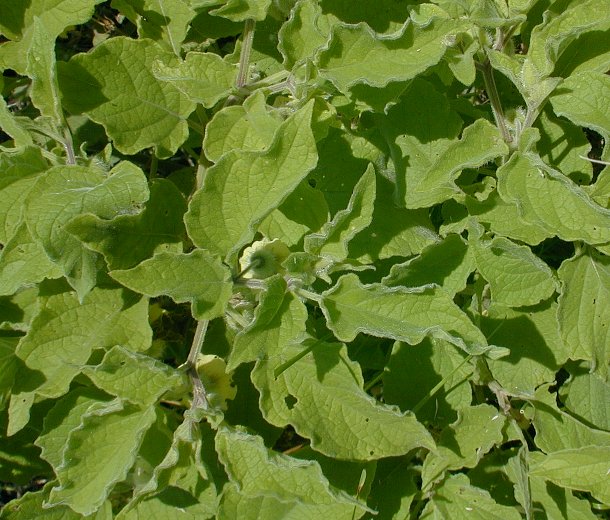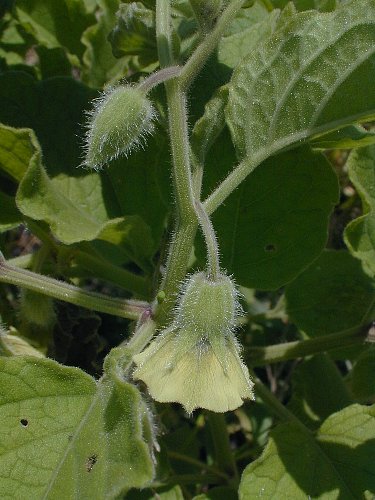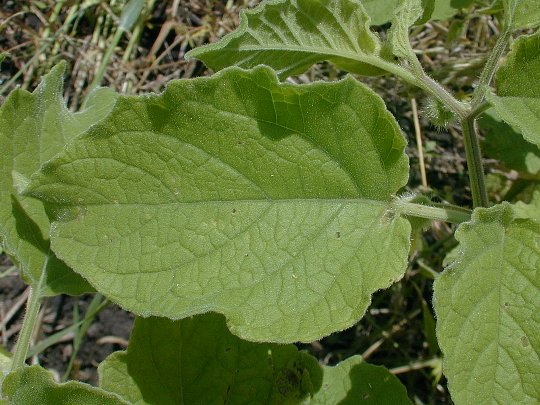Description: This perennial plant is 1½–2½' tall, branching frequently. The stems are usually round and covered with white hairs. The alternate leaves are whitish or yellowish green, and up to 4" long and 3" across. They are cordate or broadly lanceolate, with a well-rounded base. The leaf margins are horizontally wavy and irregular, and often undulate vertically as well. Both the leaves and their petioles are covered with fine white hairs, and have a rather soft texture. These hairs are sometimes glandular. A single drooping flower appears at the juncture of two divergent stems. It is up to ¾" across, and consists of a spreading tubular corolla that is pale yellow and divided into 5 very shallow lobes. There are 5 brownish purple splotches near the base of the corolla and 5 prominent dull yellow anthers. The pedicels of the flowers exceed 1/5" when fully developed, while the calyx has triangular teeth; they are both covered with fine white hairs. Later, the flowers are replaced by heart-shaped husks that are up to ¾" long, each containing a single fruit. The husk of the fruit is initially green, but later turns brown, and is indented at the base. The spherical fruit is about ½" across and becomes yellow when mature. It contains numerous light brown seeds that are elliptical and granular. On a typical mature plant during the summer, there are several buds, flowers, and husked fruit in all stages of development. The blooming period occurs during the summer and lasts about 2 months. The root system consists of deep fleshy rhizomes, which spread the plant vegetatively.

Cultivation:
The
preference is full or partial sun, and slightly moist to dry
conditions. The soil can contain substantial portions of loam, sand, or
gravel. This plant often thrives in sterile soil, or disturbed areas
with rich soil, because this reduces competition from taller, more
aggressive plants. It is fairly drought tolerant.
Range & Habitat:
Clammy Ground Cherry occurs throughout most of Illinois, except some of
the south-central and north-central counties (see Distribution
Map). This plant is native to Illinois. It can be found
occasionally in mesic to dry black soil
prairies, especially in disturbed areas. This plant also occurs in
openings of rocky or sandy upland forests, sand prairies, abandoned
fields and pastures, areas along roadsides and railroads, and various
waste areas.

Faunal Associations: Short-tongued bees collect pollen or suck nectar at the flowers. This includes the Plasterer bees Colletes latitarsis and Colletes willistoni, and some Halictine and Panurgine bees. The caterpillars of the moth Heliothis subflexus (Subflexus Straw) eat the fruit of this plant, while other insects feed on or suck juices from the foliage, including Paratrioza cockerellii (Potato Psyllid), Macrosiphum euphorbiae (Potato Aphid), and Lema trilineata (Leaf Beetle sp.). Mammalian herbivores usually don't eat this plant because the poisonous leaves and unripe fruit contain significant amounts of solanum. There has been cases of cattle being poisoned by this species and other ground cherries. Various upland gamebirds and small mammals eat the mature fruit and help to distribute the seeds, including the Bobwhite Quail, Ring-Necked Pheasant, Wild Turkey, Eastern Striped Skunk, and White-Footed Mouse

Photographic
Location:
The above photographs were taken at the edge of a prairie remnant near
a cultivated field in Champaign County, Illinois. This prairie remnant
occurred along a railroad.
Comments:
This plant has a very different appearance from Physalis
subglabrata (Smooth Ground Cherry). The most striking
features of Clammy Ground Cherry are the abundance of fine white hairs
on the foliage and the irregular shape of the rather large leaves.
Different varieties of this species have been described. It is probably
one of the two most common ground cherries in Illinois, preferring
areas that are sunny and on the dry side. The mature yellow fruit is
edible to humans.